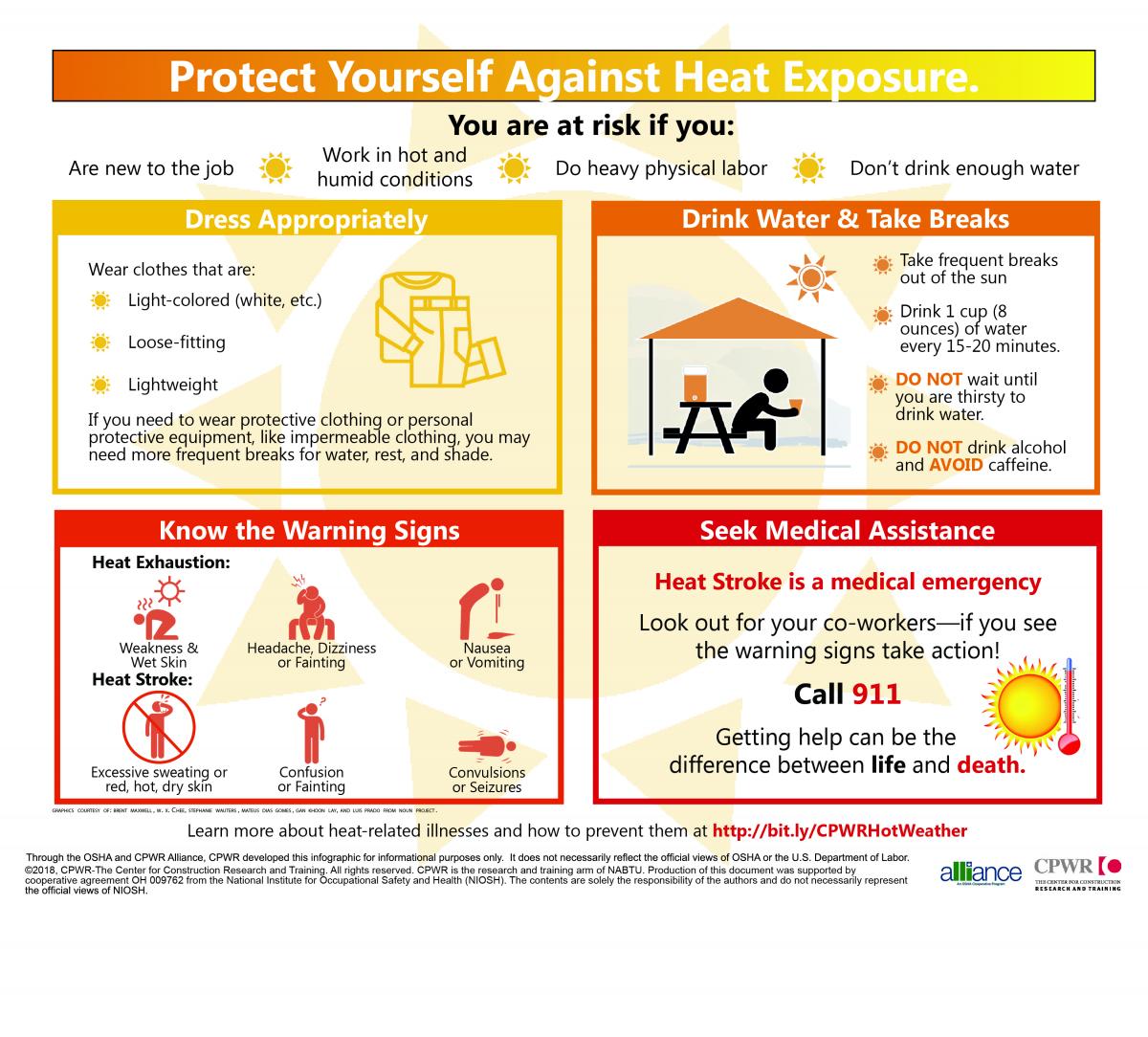Preventing Heat-Related Illnesses
Construction workers, who often work outdoors in direct sunlight or in hot, enclosed spaces, are at an increased risk for heat-related illnesses and even death. These illnesses and fatalities are preventable with an effective heat-related illness program in place on the jobsite. Prevention requires both employers and workers to recognize heat hazards and the symptoms of heat illness.
Job-related factors that increase the risk of heat-related illness and death include but are not limited to:
+ Machinery, power tools, and hot/molten materials that radiate additional heat;
+ Working in direct sunlight;
+ Physical exertion and heavy workloads generate heat in the body and cause fluids to be lost more quickly through sweat;
+ Clothing and PPE that can trap heat and reduce air flow, making it harder for the body to cool itself;
+ Lack of acclimatization,
+ Working in enclosed spaces,
+ Some medications, and caffeine.
It is important to know the symptoms of both heat exhaustion and heat stroke.
Symptoms of heat exhaustion include:
+ Weakness and wet skin;
+ Headache, dizziness, or fainting;
+ Nausea or vomiting.
Heat stroke is a medical emergency that requires immediate first aid.
HEAT-ILLNESS PREVENTION PROGRAM
Employers should develop a heat-illness prevention program and train workers, including supervisors, so they understand  heat exposure risks, preventative actions, and first aid. A crucial part of any plan is to have an Emergency Response Plan in the event workers develop heat illnesses.
heat exposure risks, preventative actions, and first aid. A crucial part of any plan is to have an Emergency Response Plan in the event workers develop heat illnesses.
The Occupational Safety and Health Administration (OSHA) and the Center for Construction Research and Training (CPWR) provide up-to-date resources on heat illness. OSHA’s Heat Illness Prevention Campaign educates employers and workers on the dangers of working in the heat.
Visit https://www.osha.gov/heat/ to access the campaign resources, and also to subscribe to The Heat Source, OSHA’s newsletter on heat illness prevention.
To access CPWR’s resources in English and Spanish, visit https://tinyurl.com/mwk5vbtx. CPWR also hosts regular webinars on a variety of topics related to occupational health and safety. To view and register for upcoming webinars, visit https://tinyurl.com/4ke62n5m.
IU Safety & Health Webinars Address Mast Climbing Safety and Fall Protections
The IU Safety and Health Department recently held webinars on mast climbing safety and fall protections.
In the Mast Climbers Safety webinar, IU Safety & Health Director Liliana Calderon, IMTEF Director of Safety Dave Wysocki, and IMTEF Regional Safety & Training Directors Dave Donkin and Dan Flores discussed how to stay safe while using mast climbers. The speakers reviewed the new American National Standards Institute’s (ANSI) standard for mast-climbing work platforms, the advantages of using mast climbers over traditional scaffolding, how to safely get on and off mast climbers, and how to avoid common hazards. Resources on the topic were provided at the end of the webinar.
The Fall Protections: ABCDE's webinar — led by BAC Secretary- Treasurer Jerry Sullivan, Calderon, Donkin and Flores — focused on the danger of falls and how to stay safe on the job.
“Since 2021, fatalities caused by falls and elevation continue to be the leading cause of death for construction employees, counting for 378 of the 986 construction fatalities as recorded by the Bureau of Labor Statistics. Those deaths were preventable,” said Secretary-Treasurer Sullivan.
The speakers each highlighted one of the ABCDEs of fall protection:
+ The requirements of Anchorage/Anchor points;
+ The types of full-Body harnesses and how to properly wear and care for them;
+ Types of Connectors;
+ The purpose of Deceleration devices and their proper inspection; and
+ The importance of Egress/Rescue systems in the event of a fall.
Resources on the topic are provided at the end of the webinar. To watch the recorded webinar, visit: https://tinyurl.com/y7ezxdj6.
To view other recorded webinars and the schedule of upcoming webinars, visit: bacweb.org/safety.
